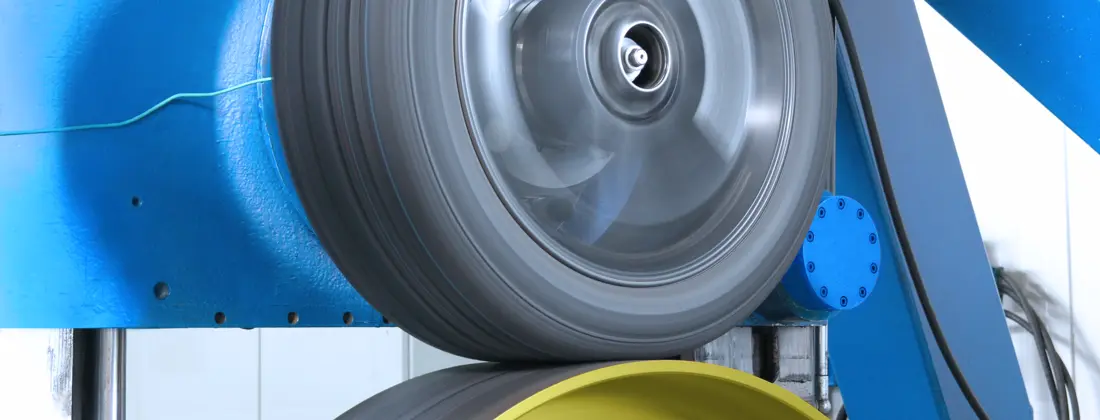ISO 28580 Rolling Resistance Tyre Testing
The ISO 28580 standard is pivotal in the automotive industry as it provides a standardized approach to measuring rolling resistance—a critical performance metric for tyres. Rolling resistance directly impacts fuel efficiency, vehicle emissions, and driving comfort. This service ensures that tyre manufacturers can accurately measure their products' rolling resistance, thereby contributing to more sustainable vehicles.
The rolling resistance test is conducted on an instrumented rolling road, which simulates real-world driving conditions while providing precise measurements of the forces involved during tyre rotation. The test procedure involves mounting a tyre on a specified wheel and measuring its resistance to deformation as it rolls at controlled speeds under standardised loads. This process generates data that helps in comparing different tyres' efficiency.
The ISO 28580 rolling resistance test is particularly important for electric vehicles (EVs) where reducing energy consumption through improved tyre design can lead to longer driving ranges and lower operational costs. For conventional vehicles, the standard ensures that tyres meet regulatory requirements regarding fuel economy and emissions.
Before conducting the tests, it's essential to prepare the specimens appropriately according to ISO 28580 guidelines. This includes ensuring the correct inflation pressure, selecting an appropriate wheel size, and maintaining consistent test conditions such as temperature and humidity levels.
The rolling resistance testing apparatus typically comprises a sophisticated rolling road system equipped with sensors capable of measuring both the force applied by the tyre on the road surface and the resulting deformation. These measurements are crucial for obtaining accurate results that reflect real-world performance.
Once the test is completed, comprehensive reports detailing the tyre's rolling resistance value alongside other relevant parameters such as load factor, speed, and temperature are generated. These reports serve multiple purposes including quality assurance, compliance verification, research & development, and supplier evaluation.
The significance of ISO 28580 cannot be overstated in today’s environmentally conscious automotive landscape. By adhering to this standard, tyre manufacturers can contribute significantly towards reducing global carbon footprints while enhancing overall vehicle performance. As more stringent regulations come into effect worldwide, reliance on such standardized testing methods becomes increasingly important.
In summary, ISO 28580 rolling resistance tyre testing plays a vital role in advancing the automotive industry by ensuring consistent quality across all components of vehicles. It supports sustainable practices and contributes to improved fuel efficiency and reduced emissions—all key factors influencing future mobility solutions.
Applied Standards
| Standard Number | Description |
|---|---|
| ISO 28580:2013 | Rolling resistance characteristics of tyres – Determination by rolling road method. |
| ASTM E746-19 | Determination of Rolling Resistance of Tires Using a Rolling Road Test. |
| EN 12857:2013 | Determination of rolling resistance of tyres – Rolling road method. |
The application of these internationally recognized standards ensures that the results from ISO 28580 rolling resistance tyre testing are reliable and comparable across different laboratories around the world. Compliance with these standards is crucial for maintaining high-quality standards within the industry and meeting regulatory requirements.
Scope and Methodology
| Parameter | Description |
|---|---|
| Type of Testing | Rolling resistance measurement using an instrumented rolling road. |
| Test Conditions | Controlled temperature, humidity, and speed. |
| Specimen Preparation | Inflation to specified pressure, correct wheel size selection. |
| Data Collection | Force measurements during tyre rotation. |
The scope of ISO 28580 rolling resistance tyre testing includes the determination of a tyre's rolling resistance coefficient (CR), which is expressed in kg. The methodology involves mounting the tyre on an instrumented wheel and subjecting it to specified loads while rolling at different speeds under controlled conditions.
During the test, detailed data such as force versus deformation curves are captured using high-precision sensors integrated into the rolling road system. This data provides insights into how efficiently a tyre converts kinetic energy into motion without unnecessary frictional losses.
The results obtained from these tests play an integral role in assessing various aspects of tyre performance including fuel economy, driving range for EVs, and overall vehicle efficiency. Compliance with ISO 28580 ensures that manufacturers produce tyres that meet stringent quality benchmarks set by international standards organizations.
International Acceptance and Recognition
- This service is widely accepted in countries adhering to European Union (EU) directives on tyre labeling.
- It aligns with United States Environmental Protection Agency's (EPA) fuel economy ratings for tyres.
- The results are recognized by the International Organization for Standardization (ISO).
- Affirmed by the American Society for Testing and Materials (ASTM).
Beyond its technical accuracy, ISO 28580 rolling resistance tyre testing enjoys broad international acceptance due to its alignment with global sustainability goals. Many nations incorporate these standards into their national regulations governing vehicle emissions and fuel efficiency.





